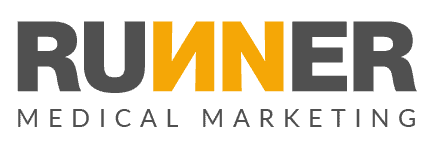
Growing your practice often means making an investment in paid advertising. So how do you calculate the return on investment for your medical marketing?
For this post, we created a video to walk you through a real-world template to determine your medical marketing ROI.
Watch the complete video below:
How many patients can I expect from my advertising?
This is a common question we get from many medical practices at RUNNER. You’re trying to understand what your medical practice marketing ROI is. What’s your return on investment for the ad spend that you’re putting out there? Another way that we hear practices talk about this is I need to generate five new patients a week, right? I need to generate a certain amount of new patients to fill up a schedule or to add a new physician to the practice.
Today I’m going to go through all of the important marketing KPIs that exist along the patient journey from your initial ad spend, to an OV, to a treatment and all the way through to profit for the practice.
AND I also want to show you what happens when one of those KPIs isn’t performing.
Let’s start by talking through some of the specific KPIs that are worth looking at.
First we have your monthly media spend. In this example, it’s an $8,000 spend. A very important calculation that you need to make to figure out how much you can get out of that monthly ad spend is what your average cost per click is. So in this case, I’m using Google Ads, Google search ads as an example. So for this particular industry that I looked at, the average cost per click was about $6.
So out of that $8,000 a month, if I divide that by six that will tell me the estimated number of clicks that I can actually get. So remember Google Ads is a cost per click platform. You only pay when a click happens. So for that $8,000, you’re getting approximately 1,333 clicks. So those are clicks to your website.
But in order for those to turn into patients, those specific people have to become a lead. So a lead in most medical practices is going to be a phone call or a form submission on your site to request an appointment. The average lead conversion rate of a website for a medical practice is about 4%, according to benchmark data from Unbounce. Higher performing practices will see higher lead conversion rates. But in this case, for that average lead conversion rate, I’m getting about 53 new patient leads from my Google search ads campaign.
And in this example, if I divide that $8,000 a month ad spend by those 53 leads, I’m essentially paying $150 per lead.
The next piece of this formula is extremely important – it’s your lead to OV rate. This is a measurement of how good your front desk is at turning leads into office visits. We’ve worked with a number of medical practices and 15% is a decent lead to OV rate. Of course we’ve seen lower and higher. Some of this depends on your medical specialty.
For example, in spine surgery you should see a pretty high lead to OV rate because if people are reaching out to you, they’ve obviously got something going on with their back and they need to see a physician immediately. However, in industries or specialties like aesthetics you may have to do some selling before a patient is willing to come in. Or, if you’re offering a free consultation and people aren’t as clear about what you do, your lead-to-OV rate can be much lower.
However, usually when your lead-to-OV rate is low, it’s because your front office is not following up in the right way. They’re missing calls or not calling back enough times.
This is the shared responsibility of medical marketing ROI.
Your marketing agency has an obligation to make sure you’re getting qualified traffic and qualified leads from your ads or through the website. But once that call is made or that form is submitted, it’s really up to your front office to perform.
Let’s shift from leads to looking at OVs. So in this example, you’re essentially gettin eight total OVS.
The next most important question is how many of those people that come in for an office visit are going to be indicated for treatment?
If you’re a surgical specialty, not every ov that comes in is going to be indicated for a surgery. If you provide a free consultation, not every patient is going to actually book a treatment. What we want to understand is your treatment indication rate. IE, the % of your office visits that book some sort of additional treatment that provides revenue for your practice.
This is going to vary wildly depending on specialty, as well as the patient experience with your physician. The 75% that I’ve included in this example is very high, but for many medical practices, they could see seven or eight out of 10 patients actually end up booking a treatment.
In this example, those 8 OVs drive six treatments. That puts the cost per treatment $1,333.
So in order for this to be profitable, in order for you to see ROI, you have to have a revenue per treatment that is more than that.
If you have a much lower revenue per patient number, it’s gonna be a lot harder to see ROI if you’re having to pay a $6 cost per click. And in this example, this practice has a $7,000 ish gross profit per treatment. That actually means that for this $8,000 that they spent, they’re actually grossing $44,598 for all of those six treatments.
So how can you see even more ROI? By improving your marketing performance.
The second example I have here for you is when your marketing performance is better.
Let’s take the same example we just walked through.
If all I do is I lower my cost per click from $6 to $4 and increase my lead conversion on the website from 4% to 5%:
- My estimated clicks go up to 2000
- My total new patient leads went from 53 to a hundred
- My cost per lead went down to $80.
- My lead to OV rate, I kept the same, but I end up with almost twice as many treatments
What happens to ROI when your front office isn’t converting new patient leads well?
In the first example I showed you, the lead-to-OV rate was 15%, which is fairly good, but let’s assume we’re in a much more competitive medical speciality, or there’s more education that’s needed, or your front office just isn’t following up well, and that lead-to-OV rate goes from 15% to 5%.
Then in this case, again, your advertising is delivering the same amount of clicks and leads. But because of that poor lead-to-OV rate:
- Your OVs go down to 3
- Your treatments go down to 2
- Your cost per OV skyrockets, to three times higher
- And your profit is only ⅓ of the first example we talked through
Sometimes, the most impactful change you can make to your medical marketing ROI is lead handling.
Putting it All Together
Hopefully these examples give you a better sense of how you can calculate ROI for your medical practice marketing.
This is a good exercise to go through as you’re planning your marketing strategy to understand what platforms you should be using. If the cost-per-click is too high in Google, maybe you need to move to another platform.
Or if your revenue-per-patient isn’t high enough then maybe you need to move to another channel as well.
Whatever the case, this model will provide guidance on how many patients you can expect, and how to calculate if it’s possible for you to see a return on your marketing investment.
If you’re interested in speaking with one of our medical marketing experts to walk you through this ROI forecasting and understand how much you should be spending, make sure to request a free consultation.




